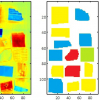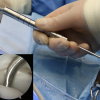It is inefficient to periodically draw blood from someone's neck to check oxygen levels, especially when that person is in an intensive care unit for massive blood loss. Yet the invasive procedure is currently the standard method for monitoring the status of hypovolemic and septic shock, the common consequence of haemorrhage that causes poor oxygen circulation and can lead to organ failure and death. In a quest for a better monitoring technique, researchers from the University of Electronic Science and Technology of China have developed a portable probe that uses near infrared (NIR) light to measure blood oxygen saturation in the tissue surrounding the central internal jugular vein in the neck—allowing doctors to continuously monitor a patient’s recovery from shock without the need to draw and analyse blood continuously. The researchers describe the work in a paper in Biomedical Optics Express.
“When I spoke with doctors and patients in hospitals, I had a strong desire to help them with my technologies”, said Ting Li, associate professor, State Key Lab of Electronic Thin Film and Integrated Device, University of Electronic Science and Technology of China, in Chengdu. “The standard method to monitor shock is invasive, discontinuous, and time-consuming”, she said.
Li’s previous work has consisted of developing a muscle oxygenation monitor, a diffuse optical correlation spectrometer for measuring blood flow and a near infrared spectrometer for measuring brain activity.
When Li and her colleagues turned to shock monitoring, they considered an array of blood-oxygen indices to test for shock—oxygen delivery, oxygen consumption, blood lactate levels, central venous oxygen saturation, artery oxygen saturation, partial pressure of oxygen and pulse oxygen saturation—but only the last can currently be done non-invasively.
The researchers’ NIR spectroscopy device consists of a probe with two detectors and a triple-LED that emits light at wavelengths of 735 nm, 805 nm and 850 nm. Since the gold standard for measuring blood-oxygen levels is oxygen saturation at the central vena cava, where a catheter would be attached, they placed the probe on the skin above the internal jugular vein. The researchers used ultrasound to guide the placement of the probe on the skin right over the patients’ veins.
To test their device’s accuracy at correlating the reflected wavelengths of light with blood oxygen saturation, Li and her colleagues compared its results against the standard catheter system, in which blood is drawn and analysed, in 25 patients exhibiting shock at intensive care unit of Xinhua Hospital, Shanghai, China, finding that finding that it agreed closely with the current method.
Future work for Li and her colleagues includes developing wireless and cellphone-controlled NIR spectroscopy devices for shock monitoring, as well as devices for monitoring functional brain activities, breast tumour growth and thrombosis.


















